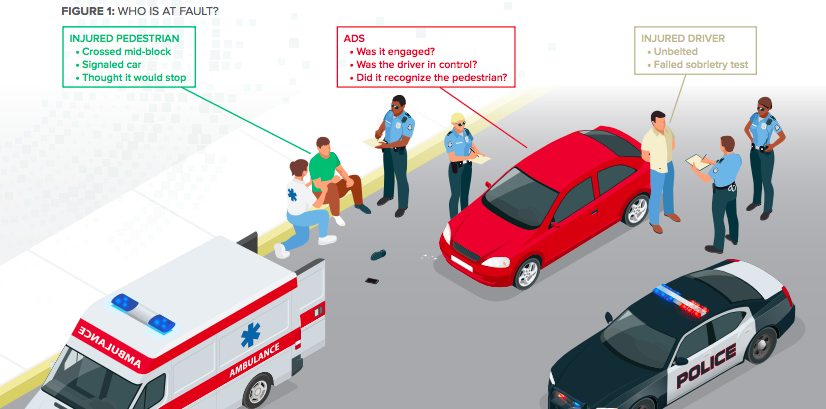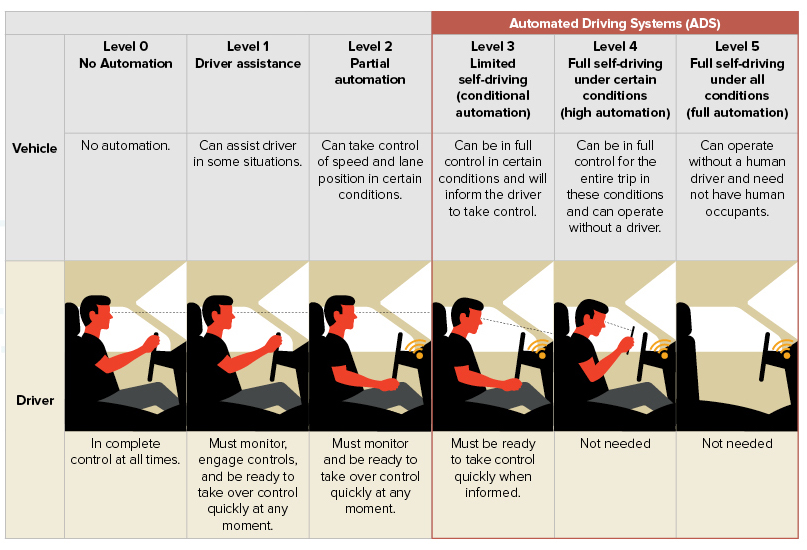GOVERNORS HIGHWAY SAFETY ASSOCIATION (GHSA)
The year is 2023. Some automated driving system (ADS) vehicles are on the road: vehicles that can operate without driver control under certain conditions. An officer is called to a crash scene. A car with an ADS had struck a pedestrian. The car had a single occupant, sitting in the driver’s seat. The occupant and the pedestrian were both injured but not seriously. The occupant was unbelted. He said he was riding home from a night at the bar.
He failed a field sobriety test. The pedestrian was crossing the road mid-block, not at a crosswalk. He said that he thought that the car was ADS-equipped so expected it to stop for him. Also, he had signaled to the person in the driver’s seat that he wanted to cross and believed that he had signaled for him to go ahead. But the car didn’t slow down when he stepped off the curb.
The officer has many questions. Can he tell that the car was ADS equipped? Was the car operating automatically at the time of the crash or was the driver in control? Had the car informed the driver that the driver should take control? If the car was in control, should the driver be charged with impaired driving and failure to wear his seat belt? Why did the pedestrian think that the car was equipped with an ADS? Why did he think that it would stop for him even though the car had the right-of-way? Why did he think the driver signaled to him to cross? And why didn’t the ADS recognize the pedestrian and immediately stop? Ultimately, who or what was at fault: the car, the driver, the pedestrian, or all three?
This is a preview of what’s coming, and coming soon, as automated vehicles enter the fleet. They are called by various names, including autonomous vehicles, vehicles with automated systems, and self-driving cars. In this report, an automated vehicle (AV) is a vehicle with any automated feature and an automated driving system (ADS) vehicle is an AV capable of operating without a driver in control for at least brief periods under certain conditions. The next section gives more detailed definitions and classifications.
AVs, especially ADSs, promise to increase mobility, in particular for those who cannot drive, and reduce traffic crashes enormously, as over 90% of crashes involve driver error. But they also raise important traffic safety concerns that states must address, especially during the many years ahead when AVs and ADSs will share the road with vehicles driven by humans.
This report should help states understand and address these concerns. It’s written for state Departments of Transportation (DOTs), Departments of Motor Vehicles (DMVs), and highway safety offices (SHSOs). It concentrates on the behavioral traffic safety issues relevant to SHSOs, especially those involving law enforcement and public education. It does not discuss in detail AV technology, driver licensing, vehicle registration, liability and insurance, or the access to and use of data produced by AVs. It does not address the many other areas affected by AVs such as infrastructure, employment, commuting patterns, and cybersecurity.
The report presents basic information about AVs, outlines their behavioral traffic safety issues, and describes what states should and should not do to encourage AV development and implementation while protecting public safety. The report is arranged in the following sections:
- AV and ADS definitions and descriptions. The levels of automation; how a completely driverless vehicle works.
- AV and ADS status, plans, and projections. What’s here now; what’s coming; scenarios for ADS penetration into the vehicle fleet; what the public thinks about AVs and ADSs.
- Behavioral traffic safety issues of AVs and ADSs. The hybrid fleet of AVs, ADSs, and vehicles driven by humans; interactions with other road users; what the public should know about how AVs and ADSs operate.
- What states should do to prepare for ADS testing and deployment. Current state activities and laws concerning ADSs, management structure, traffic laws, vehicle registration and identification, driver licensure, law enforcement issues, crash response and investigation, how to inform the public about AVs and ADSs, liability and insurance, access to data produced by AVs and ADSs.
- What national organizations are doing and should do to assist states.
- Sources of additional information.
Download full version (PDF): Preparing for Automated Vehicles
About Governors Highway Safety Association (GHSA):
https://www.ghsa.org/
GHSA is a 501(c)(3) nonprofit representing the state and territorial highway safety offices that implement federal grant programs to address behavioral highway safety issues. GHSA’s mission is to provide leadership and advocacy for the states and territories to improve traffic safety, influence national policy, enhance program management and promote best practices.
Tags: ADS, Automated Driving System, Autonomous Vehicles, AV, GHSA, Governors Highway Safety Association, safety, States, traffic laws









 RSS Feed
RSS Feed